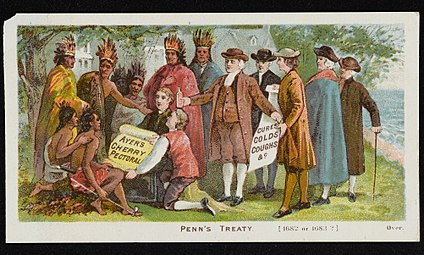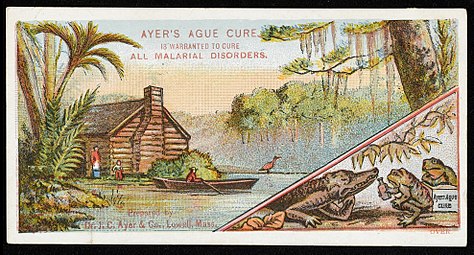| James Cook Ayer | |
|---|---|
 | |
| Born | (1818-05-05)May 5, 1818 Groton, Connecticut |
| Died | July 3, 1878(1878-07-03) (aged 60) Winchendon, Massachusetts |
| Burial place | Lowell Cemetery |
| Occupation | Businessman |
| Spouse |
Josephine Mellen Southwick
(m. 1850) |
| Children |
|
| Relatives |
|
| Signature | |
 | |
James Cook Ayer (May 5, 1818 – July 3, 1878) was the wealthiest patent medicine businessman of his day.
Early life
James Cook Ayer was born in Groton, Connecticut, on May 5, 1818, the son of Frederick Ayer (1792-1825) and Persis Herrick Cook (1786-1880). After his mother remarried, James Ayer and his brother Frederick Ayer moved to Lowell, Massachusetts, and lived with his uncle, James Cook.
He attended Lowell High School in 1838, after which he was apprenticed to James C. Robbins, a druggist in Lowell. While there he studied medicine, and later he graduated from the medical school of the University of Pennsylvania.
Career

Ayer never practiced medicine, but devoted his principal attention to pharmaceutical chemistry and the compounding of medicines. His success in this line was very great, and soon led him to establish a factory in Lowell for the manufacture of his medicinal preparations, which became one of the largest of its kind in the world, and was magnificently equipped. He accumulated a fortune estimated at $20,000,000.
Much of his success was due to his advertising, on which he spent $140,000 a year, and he annually published an almanac, distributing 5,000,000 copies each year. Editions in English, French, German, Portuguese, and Spanish, were regularly issued. In 1874 he accepted the Republican nomination for the United States Congress in the 7th Massachusetts District, but was defeated.
In addition to his patent medicine business, Dr. Ayer was involved in textile production in Lowell, Massachusetts, with his brother.
Personal life

In 1850, Ayer married Josephine Mellen Southwick (1827–1898). They had three children:
- Frederick Fanning Ayer (1851–1924)
- Henry Southwick Ayer (1853–1932)
- Lesley Josephine Ayer Pearson (1855–1928)
His son, Frederick Fanning Ayer became a lawyer and philanthropist, and was director or stockholder of many corporations.
He died in an insane asylum on July 3, 1878, and is interred at Lowell Cemetery.
Legacy
The monument at Ayer's gravesite, a life-size marble lion sculpted by Albert Bruce-Joy, is one of the best known at Lowell Cemetery.
The town of Ayer, Mass., was named after him.
Gallery
-
 Advert for Ayers Cherry Pectoral
Advert for Ayers Cherry Pectoral
-
 Advert for Ayers Ague Cure
Advert for Ayers Ague Cure
-
 Advert for Ayers Pills
Advert for Ayers Pills
-
 Advert for Ayers Cathartic Pills
Advert for Ayers Cathartic Pills
See also
References
- ^ "Obituary" (PDF). The New York Times. July 4, 1878. p. 5. Retrieved December 5, 2021.
- ^ One or more of the preceding sentences incorporates text from a publication now in the public domain: Wilson, J. G.; Fiske, J., eds. (1900). "Ayer, James Cook" . Appletons' Cyclopædia of American Biography. New York: D. Appleton.
- ^ "James Cook Ayer, Sarsaparilla King of Lowell, Mass. - New England Historical Society". May 5, 2014. Retrieved August 17, 2016.
- Short Bio on F.F. Ayer, 1914
- Camire, Chris (June 16, 2016). "What a site! The Lowell Cemetery celebrates its 175th anniversary and the 'serenity of nature'". The Sun. Retrieved August 26, 2019.
- Howe, Jr., Richard P. (November 16, 2015). Lowell. Arcadia Publishing. p. 45. ISBN 978-1467134019. Retrieved August 26, 2019.
External links
- Article about Dr Ayer
- Myths refuted about Dr. James Cook Ayer With more information about his products and life.
- Coburn, Frederick William (1920). History of Lowell And Its People, Volume 2. New York: Lewis Historical Publishing Company. pp. 16–22. Retrieved August 23, 2009.
ayer.
James Cook Ayer
By James Cook Ayer Categories:
- American manufacturing businesspeople
- Businesspeople from Massachusetts
- Ayer, Massachusetts
- 1818 births
- 1878 deaths
- People of the American Industrial Revolution
- Patent medicine businesspeople
- People from Groton, Connecticut
- People from Lowell, Massachusetts
- Perelman School of Medicine at the University of Pennsylvania alumni
- Deaths in mental institutions
- 19th-century American businesspeople